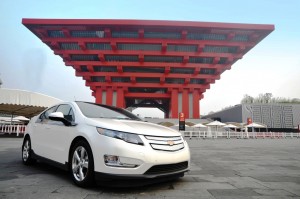
GM will not provide the Chinese with the technology secrets of the Chevy Volt, a senior official insists.
General Motors’ new joint venture with its Chinese partner SAIC will focus on the development of an all-new battery-electric vehicle, a senior GM official says.
The U.S. automaker will not provide the Chinese with intellectual property for what many see as its crown jewel, the extended-range electric vehicle Chevrolet Volt, insisted Vice Chairman Steve Girsky. But, during a media conference call hosted from Shanghai, the former Wall Street analyst acknowledged that GM will be sharing significant intellectual property with its Chinese partner.
The deal, signed today by GM officials and their counterparts at the Shanghai Automotive Industrial Corp., is the latest in a series of partnerships between the two manufacturers. It will take aim at what some believe could become the fastest-growing segment in the booming Chinese automotive market.
Worried about the country’s dependence upon foreign oil and hoping to clear up endemic smog problems, the Beijing government plans to invest billions of dollars in an effort to create a market for various forms of battery electric vehicles in the coming years.
“We do not want to be left out,” GM Vice Chairman Girsky told reporters when asked about the logic behind the latest partnership between the U.S. maker and SAIC.
Complicating matters, the Chinese drive to electrify its automotive industry will offer significant incentives only for vehicles produced domestically. As an import, Volt will not only lose out on those cash subsidies but will also be subjective to hefty import incentives. As a result, Girsky acknowledged “We don’t know” how much demand there will be for the plug-in hybrid, which went on sale in the U.S. market late in 2010.
But GM still wants to test the waters in China and other markets for Volt’s technology to help it decide how much demand there might be and “if, when and where” the Chevy battery car might be built in the future. For now, production is limited to a single plant in Detroit.
The push to electrify the Chinese market has created something of a conundrum for Beijing, as that country’s domestic automakers are generally thought to lag behind in electric vehicle technology – even though some of the world’s biggest lithium-ion battery suppliers are based in China. And the country has some of the largest supplies of the various raw materials used in electric motors and other battery car components, such as the metal neobdynium, used in high-performance magnets.
With the new deal – its 11 partnership with GM – SAIC could get a jump on other Chinese domestic manufacturers.
In the strange bedfellow world of Chinese automotive manufacturing, foreign makers like GM must partner with domestic makers like SAIC. But those Chinese brands, in turn, often form additional foreign alliances. SAIC, for example, is also a partner with Germany’s Volkswagen AG.
But GM Vice Chairman Girsky said that has not proved to be a problem, as “We’ve seen no leakage of intellectual property.”
That makes the GM/SAIC relationship unique in a country where foreign IP ownership is widely flouted in fields ranging from film to pharmaceuticals.
Details of the new GM/SAIC project are not yet being released. In particular, the makers won’t say when they expect to bring the fruits of the new venture to market, nor whether there will be a family of battery-electric vehicles. Girsky did hint that both GM and SAIC will get at least one product each to market under their own brand names.
Unlike Volt which combines both battery power and a backup internal combustion engine on a single platform, the new products will rely on a newly developed battery-electric “architecture,” one that will be powered solely by lithium-ion batteries.
The two will share costs equally, but GM apparently will offset some of its expenditures by contributing some of its current battery-electric know-how. While that may not include some of the plug-in hybrid technology from Volt, it will include some more generic knowledge about batteries, power controllers and electric motors, Girsky confirmed.
That may still trigger some opposition in government circles, word of the proposed GM/SAIC venture leading some skeptics to question whether the Chinese will be able to use this know-how for other purposes, perhaps military, or simply to help other Chinese firms to compete unfairly.
GM officials downplay that possibility and stress that they need to advance their battery car efforts here and abroad. But Girsky conceded it is still far too early to know for sure just how popular such vehicles will be.
For one thing, a large portion of the Chinese population lives in cities where there are no garages to mount electric vehicle chargers.
“It’s one of those chicken and egg things,” the executive said. There won’t be a lot of demand until there’s an infrastructure and won’t be an infrastructure until there’s a lot of demand.” But the Chinese government may help resolve that riddle, Girsky added, with its massive commitment to promote a battery car market.

“Beijing government plans to invest billions of dollars in an effort to create a market for various forms of battery electric vehicles in the coming years.”
As long as we have the Republican party here that will do anything in their power to protect their oil buddies we won’t see anything like that happening here.
“In the strange bedfellow world of Chinese automotive manufacturing, foreign makers like GM must partner with domestic makers like SAIC.”
Yet the Chinese can come over here and open a plant anytime that want to. If I’ve said it once I’ve said it a hundred times. These Free Trade Agreements are not Fair. The only purpose they really serve is to allow American Companies to ship millions of high paying jobs oversea and now look where that has got us.